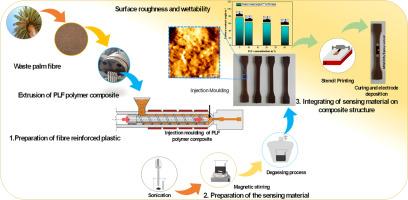可持续高性能天然纤维复合材料与集成应变传感航空和汽车应用
IF 6.3
2区 材料科学
Q2 CHEMISTRY, PHYSICAL
引用次数: 0
摘要
将传感能力集成到可持续材料制成的结构中,为先进的应用提供了重要的机会。本研究使用可持续棕榈叶纤维(PLF)开发智能纤维增强复合材料,专门用于汽车内饰应用,如仪表板、门饰、座椅结构和中控台部件,以及航空客舱内饰,包括壁板、头顶隔间、座椅框架和厨房结构。开发的复合材料具有与传统纤维复合材料相当的机械性能,同时为内部系统的结构健康监测提供集成传感能力。系统调查显示,10 wt.%的PLF含量在机械性能和适合内部组件要求的传感功能之间提供了最佳平衡。这种最佳性能是通过PLF掺入提供的增强的机械性能和表面特性来实现的,其中棕榈叶纤维由于羟基和其他极性功能而促进极性相互作用,从而改善亲水性和中间表面特性,这对传感应用至关重要。由此产生的智能复合材料具有优异的应变灵敏度,测量系数约为27,可实现实时监控。开发的生物基复合材料具有显著的成本优势,与传统纤维系统相比,生产成本降低了30 - 40%,并展示了大规模生产的可扩展制造潜力。这项工作表明,具有先进传感能力的可持续、环保材料的成功开发有望应用于汽车和航空航天领域,为更绿色、更安全的未来做出贡献。本文章由计算机程序翻译,如有差异,请以英文原文为准。

Sustainable high-performance natural fiber composites with integrated strain sensing for aeronautics and automotive applications
Integrating sensing capabilities into structures made of sustainable materials presents significant opportunities for advanced applications. This study develops smart fibre-reinforced composites using sustainable palm leaf fibres (PLF) specifically designed for automotive interior applications such as dashboard panels, door trim, seat structures, and centre console components, as well as aeronautic cabin interiors including wall panels, overhead compartments, seat frames, and galley structures.
The developed composites demonstrate mechanical properties comparable to conventional fibre composites while offering integrated sensing capabilities for structural health monitoring of interior systems. Systematic investigation reveals that 10 wt.% PLF content provides optimal balance between mechanical performance and sensing functionality suitable for interior component requirements. This optimal performance is achieved through the enhanced mechanical properties and surface characteristics provided by PLF incorporation, where the palm leaf fibres promote polar interactions due to hydroxyl groups and other polar functionalities, resulting in improved hydrophilicity and intermediate surface characteristics that are critical for sensing applications. The resulting smart composite exhibits exceptional strain sensitivity with a gauge factor of approximately 27, enabling real-time monitoring. The developed bio-based composites offer significant cost advantages with 30–40 % reduced production costs compared to conventional fibre systems and demonstrate scalable manufacturing potential for mass production.
This work demonstrates the successful development of sustainable, eco-friendly materials with advanced sensing capabilities that show promise for automotive and aerospace applications, contributing to a greener and safer future.
求助全文
通过发布文献求助,成功后即可免费获取论文全文。
去求助
来源期刊

Surfaces and Interfaces
Chemistry-General Chemistry
CiteScore
8.50
自引率
6.50%
发文量
753
审稿时长
35 days
期刊介绍:
The aim of the journal is to provide a respectful outlet for ''sound science'' papers in all research areas on surfaces and interfaces. We define sound science papers as papers that describe new and well-executed research, but that do not necessarily provide brand new insights or are merely a description of research results.
Surfaces and Interfaces publishes research papers in all fields of surface science which may not always find the right home on first submission to our Elsevier sister journals (Applied Surface, Surface and Coatings Technology, Thin Solid Films)
 求助内容:
求助内容: 应助结果提醒方式:
应助结果提醒方式:


